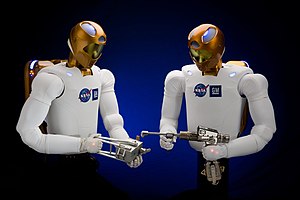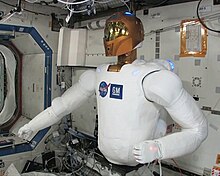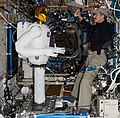
The International Space Station (ISS) is a large space station assembled and maintained in low Earth orbit by a collaboration of five space agencies: NASA, Roscosmos (Russia), JAXA (Japan), ESA (Europe), CSA (Canada), and their contractors. ISS is the largest space station ever built. Its primary purpose is performing microgravity and space environment experiments.
Human spaceflight programs have been conducted, started, or planned by multiple countries and companies. Until the 21st century, human spaceflight programs were sponsored exclusively by governments, through either the military or civilian space agencies. With the launch of the privately funded SpaceShipOne in 2004, a new category of human spaceflight programs – commercial human spaceflight – arrived. By the end of 2022, three countries and one private company (SpaceX) had successfully launched humans to Earth orbit, and two private companies had launched humans on a suborbital trajectory.

Telerobotics is the area of robotics concerned with the control of semi-autonomous robots from a distance, chiefly using television, wireless networks or tethered connections. It is a combination of two major subfields, which are teleoperation and telepresence.

The Mobile Servicing System (MSS), is a robotic system on board the International Space Station (ISS). Launched to the ISS in 2001, it plays a key role in station assembly and maintenance; it moves equipment and supplies around the station, supports astronauts working in space, and services instruments and other payloads attached to the ISS and is used for external maintenance. Astronauts receive specialized training to enable them to perform these functions with the various systems of the MSS.

Michael Landon Gernhardt is a NASA astronaut and manager of the Environmental Physiology Laboratory, and principal investigator of the Prebreathe Reduction Program (PRP) at the Lyndon B. Johnson Space Center.

Dextre, also known as the Special Purpose Dexterous Manipulator (SPDM), is a two-armed robot, or telemanipulator, which is part of the Mobile Servicing System on the International Space Station (ISS), and does repairs that would otherwise require astronauts to do spacewalks. It was launched on March 11, 2008, on the mission STS-123.
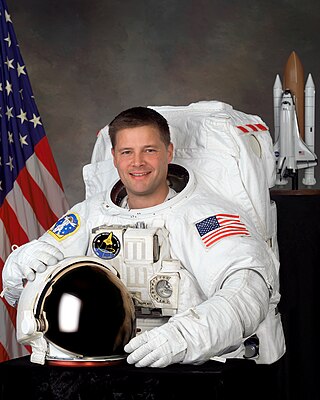
Douglas Harry "Wheels" Wheelock is an American engineer and astronaut. He has flown in space twice, logging 178 days on the Space Shuttle, International Space Station, and Russian Soyuz. On July 12, 2011, Wheelock announced that he would be returning to active duty with the United States Army in support of Operation Enduring Freedom. He is currently working with NASA to test the Orion spacecraft at the Glenn Research Center in Plum Brook, Ohio.
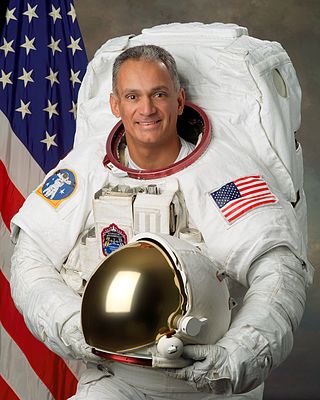
John Daniel "Danny" Olivas is an American engineer and a former NASA astronaut. Olivas has flown on two space shuttle missions, STS-117 and STS-128. He performed EVAs on both missions, totaling 34hrs 28min.

STS-133 was the 133rd mission in NASA's Space Shuttle program; during the mission, Space Shuttle Discovery docked with the International Space Station. It was Discovery's 39th and final mission. The mission launched on February 24, 2011, and landed on March 9, 2011. The crew consisted of six American astronauts, all of whom had been on prior spaceflights, headed by Commander Steven Lindsey. The crew joined the long-duration six person crew of Expedition 26, who were already aboard the space station. About a month before lift-off, one of the original crew members, Tim Kopra, was injured in a bicycle accident. He was replaced by Stephen Bowen.

STS-123 was a Space Shuttle mission to the International Space Station (ISS) which was flown by Space Shuttle Endeavour. STS-123 was the 1J/A ISS assembly mission. The original launch target date was February 14, 2008, but after the delay of STS-122, the shuttle was launched on March 11, 2008. It was the twenty-fifth shuttle mission to visit the ISS, and delivered the first module of the Japanese laboratory, Japanese Experiment Module (Kibō), and the Canadian Special Purpose Dexterous Manipulator, (SPDM) Dextre robotics system to the station. The mission duration was 15 days and 18 hours, and it was the first mission to fully utilize the Station-to-Shuttle Power Transfer System (SSPTS), allowing space station power to augment the shuttle power systems. The mission set a record for a shuttle's longest stay at the ISS.

Shannon Walker is an American physicist and a NASA astronaut selected in 2004. She launched on her first mission into space on June 25, 2010, onboard Soyuz TMA-19 and spent over 163 days in space.

Akihiko Hoshide is a Japanese engineer, JAXA astronaut, and former commander of the International Space Station. On August 30, 2012, Hoshide became the third Japanese astronaut to walk in space.

Michael Reed Barratt is an American physician and a NASA astronaut. Specializing in aerospace medicine, he served as a flight surgeon for NASA before his selection as an astronaut, and has played a role in developing NASA's space medicine programs for both the Shuttle-Mir Program and International Space Station. His first spaceflight was a long-duration mission to the International Space Station, as a flight engineer in the Expedition 19 and 20 crew. In March 2011, Barratt completed his second spaceflight as a crew member of STS-133. Barratt will pilot the SpaceX Crew-8 mission in spring 2024.

NASA's Christopher C. Kraft Jr. Mission Control Center, also known by its radio callsign, Houston, is the facility at the Lyndon B. Johnson Space Center in Houston, Texas, that manages flight control for the United States human space program, currently involving astronauts aboard the International Space Station (ISS). The center is in Building 30 at the Johnson Space Center and is named after Christopher C. Kraft Jr., a NASA engineer and manager who was instrumental in establishing the agency's Mission Control operation, and was the first Flight Director.

STS-135 was the 135th and final mission of the American Space Shuttle program. It used the orbiter Atlantis and hardware originally processed for the STS-335 contingency mission, which was not flown. STS-135 launched on July 8, 2011, and landed on July 21, 2011, following a one-day mission extension. The four-person crew was the smallest of any shuttle mission since STS-6 in April 1983. The mission's primary cargo was the Multi-Purpose Logistics Module (MPLM) Raffaello and a Lightweight Multi-Purpose Carrier (LMC), which were delivered to the International Space Station (ISS). The flight of Raffaello marked the only time that Atlantis carried an MPLM.

Expedition 34 was the 34th long-duration expedition to the International Space Station (ISS). It began on 18 November 2012 with the departure from the ISS of the Soyuz TMA-05M spacecraft, which returned the Expedition 33 crew to Earth.

Justin is an autonomous and programmable humanoid robot with two arms, developed by the German Aerospace Center (DLR) at the Institute of Robotics and Mechatronics, located in Wessling, Germany. Introduced in 2009, this wireless robot is controllable through telepresence, a type of technology that allows a person to feel as if he or she were present from a location other than his or her true location.
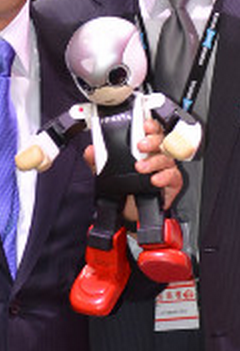
Kirobo is Japan's first robot astronaut, developed by University of Tokyo and Tomotaka Takahashi, to accompany Koichi Wakata, the first Japanese commander of the International Space Station. Kirobo arrived on the ISS on August 10, 2013 on JAXA's H-II Transfer Vehicle Kounotori 4, an unmanned resupply spacecraft launched August 4, 2013 from Japan's Tanegashima Space Center. A twin to Kirobo, named Mirata, was created with the same characteristics, and stayed on Earth as a backup crew member. The word "kirobo" itself is a portmanteau of "kibō" (希望), which means "hope" in Japanese, and the word "robo" (ロボ), used as a generic short word for any robot.

Nicolaus Adam Radford known as Nic Radford is an American engineer, roboticist, inventor, and entrepreneur raising over $250mm in funding for his companies. He is the former president and CEO of Nauticus Robotics, Inc. (NSADAQ:KITT) a robotics firm he co-founded. He also founded Jacobi Motors, his company spun out of HMI to commercialize his variable flux motor research from graduate school. He also started Rad Capital Ventures to invest in the trading of electricity. Prior to forming HMI, he spent 14 years at Lyndon B. Johnson Space Center's Dexterous Robotics Laboratory at NASA in Houston, Texas. Radford was the principal investigator tasked with leading the development of Valkyrie for participation in the 2013 DARPA Robotics Challenge (DRC) and NASA's future Mars robotics missions.
